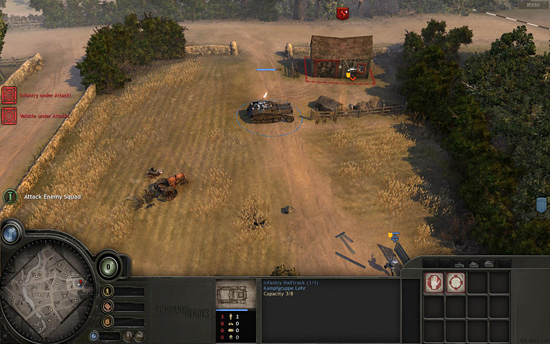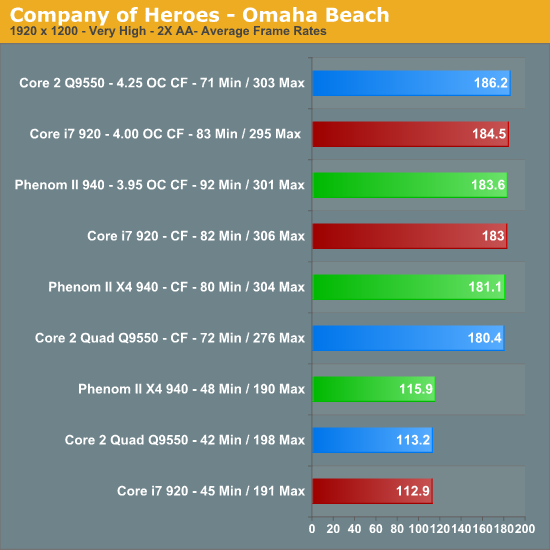CrossFireX and the Phenom II X4 940 – Competitive or Not?
by Gary Key on February 2, 2009 12:00 AM EST- Posted in
- Motherboards
Company of Heroes: Opposing Fronts

The oldest title in our test suite is still the most played. CoH has aged like fine wine and we still find it to be one of the best RTS games on the market. We look forward to the Tales of Valor standalone expansion pack this spring. In the meantime, we crank all the options up to their highest settings, enable AA at 2x, and run the game under DX9. The DX10 patch offers some improved visuals but with a premium penalty in frame rates. We track a custom replay of Able Company’s assault at Omaha Beach with FRAPS.

Just like our previous test results, we have very similar single card scores at 1680x1050. In this particular game, the Phenom II X4 940 offers the best minimum frame rates in each benchmark when compared to the Q9550 and surpasses the i7 in two tests. Only when the platform is overclocked do we see the Q9550 ahead of the Phenom II in average frame rates, a small 3% to be exact. However, the Phenom II has a 13% advantage in minimum frame rates.
Adding a second card for CrossFire operation improves average frame rates by 45% and minimum frame rates by 49% for the Phenom II. The Intel Q9550 has an improvement of 44% in the average and 81% in minimum frame rates. The Core i7 average frame rates improve by 48% and minimum rates increase 76%. Overclocking our processors resulted in a 5% average improvement in frame rates for our collective group, indicating we are largely GPU limited.
During testing, the Intel systems would generate minimum frame rates in the 23~24fps range on a couple of runs and then jump to their current results on the others. We noticed this in game play also; the Intel systems would hitch and pause at times. We would shutdown the game, clear the prefetch folder, and reboot. The game would operate fine in the next series of testing, though we still had stuttering in intensive ground scenes at times. We tried new images, different CPUs, memory changes, and the Sapphire HD 4870 cards with the same results. The Phenom II 940 had extremely stable frame rates in each test and action was very fluid during game play.

Lather, rinse, and repeat: the 1920x1200 numbers follow the same performance pattern once again - not that we expected anything different. Nevertheless, it is getting boring mentioning that same fact on every page. In single card testing the Phenom II 940 is 2% faster in average frame rates and 14% ahead in minimum frame rates compared to the Q9550. CrossFire results barely favor the Phenom II in average frame rates while minimum frame rates are about 8% better than the Q9550.
The i7 shows its strength in CrossFire testing in both average and minimum frame rates. We only experienced the previously mentioned drop in minimum frame rates a couple of times with i7 but it was still noticeable. The Q9550 finishes first again in average frame rates when overclocked but falls about 29% behind the Phenom II 940 in minimum frame rates.
Adding a second card for CrossFire operation improves average frame rates by 57% and minimum frame rates by 66% for the Phenom II. The Intel Q9550 has an improvement of 59% in the average and 71% in the minimum frame rates. The Core i7 average frame rates improve by 62% and minimum rates increase 82%. Overclocking our processors only improved frame rates 2% on average as we continue to be GPU bound at this resolution.
Now that we have discussed the numbers, what about the game play experience? As we alluded to earlier, the Intel platforms had problems with minimum frame rates throughout testing - not just in the benchmarks, but also during game play in various levels and online. We have not nailed it down yet, but we have noticed this problem consistently. In contrast, the Phenom II X4 940 had rock solid frame rates and offered the smoothest game play experience. The problem is very likely driver related in some manner (as the man who helped to start DirectX once put it, "the drivers are always broken"), but nevertheless this is an issue on the two Intel platforms.










68 Comments
View All Comments
FingerMeElmo87 - Monday, February 2, 2009 - link
"Seriously, who cares for Crossfire (or SLI)?Please. Stop making those useless enthusiast's enthusiast reviews and come back to the ground, AnandTech."
--Whats down to earth? Intel Celeries and IGPs'? They did both average use benches with single GPU and enthusiast class benches with dual GPUs and overclocking. how could you get your panties in a bunch like so easily. did you even bother to read the article?
"Please, go ahead, check the Steam survey hardware list.
Then tell me: How many people out of 100 do have SLI/Crossfire.
Then laugh.
Then stop testing this shit like it was important."
--Once again, same worthless comment. they didnt just test crossfire
"And here my suggestions for constructive improvement:
Test the new generation of HDDs with 500GB platters (e.g. Seagate 7200.12 series)
THAT would be interesting, because EVERYONE needs a good HDD, but no one needs Crossfire."
--ugh. saying eveyone needs the latest and greatest type of harddrive is like saying everyone needs crossfire and SLI.
going as far as breaking down your entire retarded post was a complete waste of time just to call you a douche bag but i guess it had to be done
CPUGuy - Monday, February 2, 2009 - link
The user "Finally" is right (although a tad abrasive). You don't need CF or SLI to run any of those games at an acceptable frame rate. Furthermore, the mainstream crowd does outnumber the enthusiast crowd using CF/SLI by many fold. So it would have made more beneficial to show both CPU stock and overclock results using just a 4870.Heck, they could have added a PII 920 at stock and overclock and a 4850 just to make it interesting. Maybe one day we will see such a setup tested.
scottb75 - Wednesday, February 4, 2009 - link
With SLI/CF the CPU becomes more of the bottleneck then it would be with just one GPU. So, testing with SLI/CF shows more of a difference between the CPUs then it would with just a single card.Gary Key - Monday, February 2, 2009 - link
This is not a GPU comparison per say, it is a platform comparison. We set the game options to a blended mixture of quality and performance in order to keep the GPU setup from becoming the limiting factor when possible. This is explained in further detail in page two.CPUGuy - Monday, February 2, 2009 - link
Although I understand your reasoning and to a degree it make sense. However, many are using or attempting to use 4xAA max settings at 1680 (at the very least). Therefore, it would be very informative to many of use what we could expect.This is with the expectation that we are no longer worried about just CPU scores but platform scores. IMO, reviewers should start looking at the platform as whole in reviews like this as many are looking at it that way. If it were true that one motherboard performed exceedingly better then another a CPU only benchmark would make sense.
CPUGuy - Monday, February 2, 2009 - link
us not use...sorryv1001 - Sunday, February 1, 2009 - link
Page 10 - Final Words is missingGary Key - Monday, February 2, 2009 - link
The article went live before it was completed. Page 10 is in and I will update it late tomorrow with power consumption numbers. Just finishing the power tests on the i7 with the same power supply we use on the other setups.